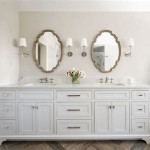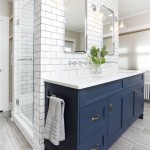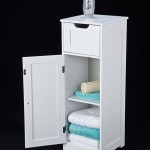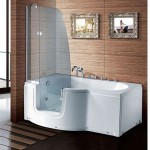How To Mix And Match Bathroom Tiles
A bathroom remodel is a great opportunity to express your personal style. Tiles, in particular, offer a wide range of designs, textures, and colors to create a unique and visually appealing space. While using a single tile type throughout the bathroom can be simple and elegant, incorporating different tiles can elevate the design and add visual interest. Mixing and matching tiles, however, requires careful planning and consideration to achieve a harmonious and cohesive aesthetic. This article provides a comprehensive guide on how to mix and match bathroom tiles effectively.
Understanding The Basics of Tile Mixing
Mixing and matching tiles in a bathroom involves incorporating different tile types in terms of material, color, size, shape, and pattern. When done effectively, this technique can create a visually dynamic and interesting space. For example, using different tile sizes can add visual interest and break up large, monotonous spaces. Incorporating patterned tiles can add a touch of character and personality, while using different colored tiles can create a sense of vibrancy and depth.
However, it is important to remember that mixing tiles should be done in a balanced and intentional way to avoid creating a chaotic or overwhelming look. Consider the overall design aesthetic and the desired mood of the bathroom. Choosing tiles that complement each other in terms of style, color, and texture is essential to achieving a cohesive and pleasing result.
Key Considerations for Mixing and Matching Tiles
When mixing and matching tiles in a bathroom, careful planning and consideration are essential to create a visually appealing and cohesive space. The following points are crucial to keep in mind:
1. Color Palette And Theme
Start by choosing a color palette and a theme for your bathroom. This will guide your tile selection and ensure that all elements work together harmoniously. For example, a classic and timeless bathroom might incorporate a neutral palette of white, gray, and black, with subtle accents of metallic finishes. A more modern and contemporary bathroom might feature bolder, brighter colors, such as turquoise, teal, or coral, combined with geometric patterns. By defining the overall theme and color scheme, you can narrow down the tile options and ensure they complement the chosen style.
2. Tile Sizes and Shapes
Consider how different tile sizes and shapes can be used to create visual interest and define different areas within the bathroom. For example, using larger tiles on the floor and smaller tiles on the walls can create a sense of balance and separation. Incorporating mosaic tiles can add a touch of elegance and detail to specific areas, such as the shower niche or around the bathtub. Experiment with different combinations of tile sizes and shapes to find a layout that is appealing and functional.
3. Tile Patterns and Textures
Patterned tiles can add character and personality to a bathroom. However, it is important to choose patterns that complement the overall style and color scheme. For example, a traditional bathroom might feature a subtle floral or geometric pattern, while a contemporary bathroom might opt for a bold geometric or abstract pattern. Consider using patterned tiles as accents on specific areas, such as the shower floor or backsplash, to avoid overwhelming the space.
Texture also plays a crucial role in creating visual interest and tactile appeal. When mixing tiles, consider using various textures to create contrasting effects. For example, incorporating textured floor tiles with smooth wall tiles can add depth and dimension to the space. Alternatively, using tiles with a matte finish on the walls and glossy tiles on the floor can create a visual contrast and enhance the sense of space.
4. Material Considerations
Different tile materials have unique characteristics and properties. Consider the following factors when selecting tiles for your bathroom:
Porcelain: Highly durable, water-resistant, and comes in various colors and styles. Ceramic: Less expensive than porcelain, but offers a wide range of designs and finishes. Natural Stone: Offers unique beauty and durability. Options include marble, granite, and slate. Glass: Offers sleek, modern aesthetic, but can be more fragile than other materials. Metal: Adds a touch of luxury and sophistication. Mosaic: Small tiles that can be arranged in various patterns and designs.
Choosing the right tile material depends on factors such as budget, desired aesthetic, and maintenance requirements. Consider the durability, water resistance, and ease of cleaning when selecting the tile material for different areas of the bathroom.
5. Layout and Installation
Once you have chosen your tiles, consider how they will be arranged. Consider creating a layout that is visually appealing and easy to maintain. For example, using a running bond pattern for floor tiles can add visual interest and prevent the tiles from looking too uniform. Incorporating a border tile around the shower or bathtub can create a sense of separation and define different areas within the bathroom.
It is important to work with a professional tile installer who can ensure that the tiles are installed correctly and securely. Proper installation is crucial for the longevity and functionality of the tiles.
6. Lighting And Grout Color
The lighting in a bathroom can greatly affect the appearance of the tiles. Natural light is always ideal, but using proper artificial lighting can enhance the colors and textures of the tiles. Consider using recessed lighting or a combination of ambient and task lighting to ensure adequate illumination throughout the bathroom.
Grout color can also impact the overall look of the tiles. Consider choosing a grout color that complements the tile colors and enhances the overall design aesthetic. Light grout colors can help make the tiles appear larger, while dark grout colors can add a touch of drama and sophistication.

How To Mix Match Bathroom Tiles Mandarin Stone

25 Stylish Ways To Mix And Match Bathroom Tiles Shelterness

Tiles Talk 5 Ways To Mix Match Tile Sizes In Your New Bathroom Perini

Mix Match Your Floor Wall Tiles Stone Tile Company

Mixing Tiles In A Bathroom 3 Simple Steps Nina Hendrick

Tiles Talk Mix And Match 6 Ways To Achieve Bathroom Bliss Perini

Ways To Mix And Match Tiles In The Bathroom Italia Ceramics

10 Ways To Mix And Match Tiles In The Bathroom

Matching Tiles Tips And Suggestions For Pairing Porcelanosa

141 Mix And Match Tile Ideas In Bathrooms Digsdigs







